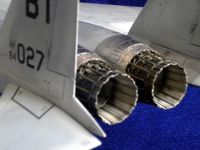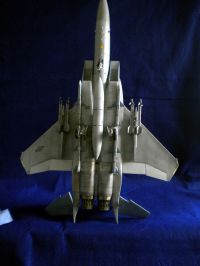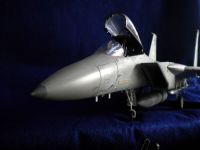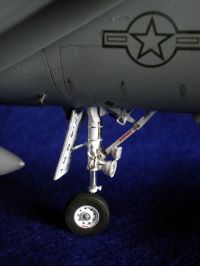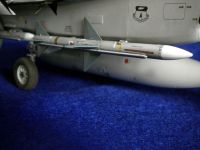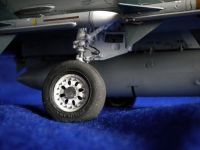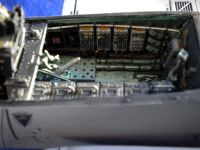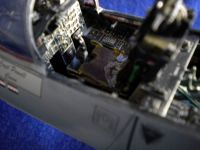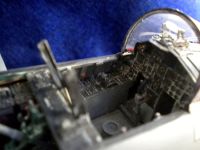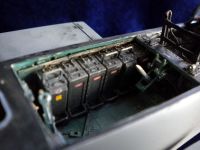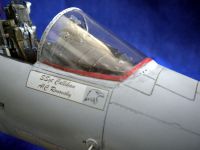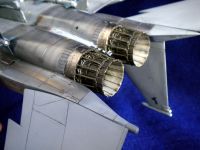Tamiya 1/32 F-15C Bitburg Eagle ODS Mig Killer 84-0027
By Gary Hatherly

The subject is McDonnell Douglas F-15C 84-0027, a dual MiG-29 killer in the hands of Cpt. Powell during Operation Desert Storm. The jet is depicted in 1992/93 after returning to Bitburg prior to repainting into the Mod. Eagle color scheme. MSIP II and HOTAS upgrades had been Completed at this time.
Base Kit:
- Tamiya F-15C 1/32 scale
Additional kits and major components used:
- Revell New tool F-4E kit - 600 Gallon Center Line Fuel tank
- Revell F-15 D/E Kit – Left fin ALQ-128 Antenna/Dampener, Tail Hook
- Academy F/A-18C – HOTAS Throttle, Misc landing gear parts, antennas, AIM-7M Sparrow Missiles
- Tamiya F-16CG Thunderbird kit. Correct afterburners and exhaust tubes
Aftermarket kits:
- Aries: F-15C late Cockpit. Coaming modified for MSIP II Update
- Wolfpack: MSIP II update set – Instrument panel stores jettison panel used
- Flightpath: F-15C Exhaust set
- Master: M61 20mm cannon
- Zacto Models: Aim-9L/M Sidewinder Missiles
- Rhino Models: Resin Intakes
- Eduard Photo etch: F-15C, F-15 Interior, F-15E Exterior, F-15E Seat, F-4C Seat, F-15 Placards, F-15 Formation Light
- Hobby decal: Metal AOA probes
Decals:
- Two Bobs Eifel Eagles
- Two Bobs Aim-7 M Sparrow
- Two Bobs Aim-9 L/M Sidewinder
- Misc. small decals from stash
- Sky Decals aircraft panel numbers and pylon/tank stencils
Major Changes and Corrections:
- Wings- thinned trailing edge, repositioned flaps, ailerons, and inboard marker light from the “E” to the “C” position
- Vertical fins- Replaced incorrect right fin balancer, left fin ALQ-128 antenna, “E” Rudder bulges removed, Rudder and fin update bolts added, thinned leading and trailing edges, cut rudder free of fin, Rescribed for “C” model of that period
- Elevators – Removed all external detail “E” bracing, thinned upper and lower halves of elevator, removed plastic tab and installed a 1.5mm x 2.5 cm brass rod for the elevator pivot. A 2mm brass tubing is installed in the fuselage to allow smooth rotation of the elevator while providing excellent strength and easy disassembly. Elevators were rescribed to restore “C” detail for the period.
- Tail hook – From the Revell F-15 kit, and reworked to match the actual parts as closely as possible
- Vent/Grills - Cockpit side vents and gun bay vents were opened up
- JFS – “E” intakes were removed and the “C” intake added. Louvered exhausts were removed along with the Sabre drains on the engine access panels
- Rescribing – Tamiya gives us an “E” top fuselage, so it needs to be reworked with some panel lines being filled in, moved and/or added to make a “C” top
- Reshaped the main rubber tires to “C” shape. The need to have the corners taken off and smoothed off without tearing the rubber or removing the side wall details. The original idea was to use the Revell main wheels and tires, but the tires are not tall enough.
- AIM-7 Missiles - detain was added and the fins were thinned down, as were the LAU-106 fuselage mounting clamps
Scratch Built items:
- Main front landing gear - the Tamiya part is OK, but the fork is way to tall and the wrong profile. It also has that clump of metal at the top that is what I don’t know, but it is not part of a real F-15.
- Main landing gear was reworked and 90% built from scratch, including the retract mechanism and the door detail and open/close mechanism
- Front canopy frame underside detail of framework, closing and locking mechanism and corresponding side sill details
- Arched read canopy frame built with proper mirrors, IFF status light, RAW lights, compass, release lever, and canopy seal.
- Front canopy frame added at the seal area
- Cockpit controls, switches, canopy locks, etc, places in correct configuration for parked jet on alert
- Fuel tank/ stores racks on pylons including reworking of the pylons for correct panel lines and surface detail
- ACES II seat rails – the seat slides into the rails like the real one
- HUD glass cut to correct shape and size and mounted into a PE frame
- Metal engine bay intake and exit cooling air ducts instead of plastic
- P&W Exhausts – I used parts from 4 PE sets and 3 different plastic model kits, plus brass and plastic stock and sheet foil.
FINISH: I used a combination of Tamiya, Model Master, and Vallejo acrylics, enamels, and lacquers for the interior details. In a few places, like bay 5, Xtracolor 159 is a special color to match the F-15 interior in an enamel, so I used it in areas to be that green color. White MM lacquer was used for the white landing gear and wheel wells.
I completely riveted the model, and then used a black enamel wash to highlight the rivet and the panel lines with the goal of having barely visible rivets, like a dirt effect in some spots. I then sprayed on the finish using MM FS 375 and 320, while mixing tones of each to get a weathered and slightly differing color affect. The nose cone is FS 270. In addition, in the areas where pre shading shows through the paint, I pre shaded with shades of gunship gray, varying it from panel to panel. All in all I used 9 different colors of Gray on the exterior. Each coat is sprayed on very thin, and then sanded with 2000 grit for a very smooth finish. Final coats were polished with a piece of clean old polyester cloth and steel wool. Futures was applied in several coats alternating with coats of Windex reduced 25% with distilled water, decals, more future, and then lacquer flat or gloss depending on the area. The bare metal area is polished. Alclad lacquers with gloss clear coat.
One item that I believe is very important is to use distilled water for ALL paint thinning/mixing when not using acrylic thinner. I used Tamiya thinners for the Acrylic and Lacquer spraying and Testers enamel thinner for the enamel paints and for cleanup.
I used an Iwata HP-CP airbrush.
I want to thank Chuck Sawyer for his help in the finishing department. In addition to taking the time to write his “How To” threads, He responded to my many PM’s and emails regarding getting the right Airbrushing equipment and learning how to use it to get high quality results. No matter how stupid my questions were. Thank you Sir!!
Please visit the build thread for more pictures and details:
http://forum.largescaleplanes.com/index.php?showtopic=46150
My great thanks to those who posted and stopped in the watch this happen.
© Gary Hatherly 2014
This article was published on Friday, March 21 2014; Last modified on Monday, February 29 2016

